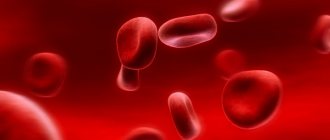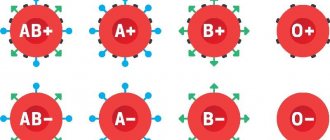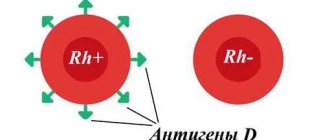What does blood type mean?
This specific combination of innate antigenic properties of red blood cells in blood cells, and antibodies to them in plasma, refers to the individual characteristics of a person. When transfused, they determine compatibility. In addition, blood type affects the bearing and birth of healthy offspring. It is divided into types depending on the content of antigens in the composition.
Who discovered blood groups? Few people know that they were “rediscovered” several times. Experiments with blood transfusions have been carried out for hundreds of years. Antibodies in the blood were first discovered by Karl Landsteiner. 30 years later he was awarded the Nobel Prize “for the discovery of human blood groups.”
The researcher first announced his observations in 1901. However, his discovery did not create the desired sensation in the scientific community. Six years of discoveries by different scientists brought confusion to the nomenclature. The problem was solved in 1907. The Czech discoverer Jan Jansky assigned numbers to blood groups - I, II, III and IV.
How did blood groups appear on the planet?
Blood is divided into groups based on the presence of certain antigens and antibodies to them. There are four main groups: 0 (I), A (II), B (III), and AB (IV). Each of them corresponds to a number, and the letter indicates the absence or presence of specific antigens. This is also an indicator of compatibility.
In humans, genetic blood parameters do not change throughout life. This is a specific identity identifier that children inherit from their parents. Groups are older than nationalities and races. The main difference between different people, according to many scientists, is not ethnic origin and skin color, but rather the composition of the blood.
The most common blood type is first. It is the most suitable for transfusion because it does not contain antigens. The second is suitable only for people of the same and fourth groups due to the presence of A antigens. The third is suitable only for owners of the third and fourth, and the last of them can only be transfused to people with the same blood group.
However, not only the presence or absence of antigens is important, but also the Rh factor. It is determined by the presence of protein on the surface of red blood cells.
If it is present, then Rh is positive, and if it is absent, it is negative. About 85% of the world's population have a positive Rh factor.
For example, the third negative blood type is much less common than the positive one. The same applies to others.
The first, the most common blood type, is found in 45% of the world population. Next in order are the rest. The rarest group is the fourth. If we take into account the Rh factor, the most common blood group is the first positive, and the rarest is the fourth negative.
The group and Rh must be taken into account when planning pregnancy. If the fetus inherits the father's blood parameters, which turn out to be incompatible with the mother's blood, then problems are possible during pregnancy. However, modern medicine is quite capable of preventing them.
The composition of the blood has been formed over many thousands of years and is associated with the formation of the immune and digestive systems. In ancient times, blood group 1 was positive for all humanity. The digestive tract was then best suited for digesting meat protein foods.
Therefore, people in this category still have high acidity of gastric juice, and they are predisposed to peptic ulcers. The first is still the most common blood type. As the human population increased, meat became less available due to its scarcity, so people increasingly began to eat plants.
This affected the qualitative composition of the blood, which led to the emergence of other groups that endowed people with many useful qualities.
How many types of blood types
"AB0" is not the only system for distributing human liquid tissue. Therefore, how many blood groups exist in the world is unknown. There are about 30 varieties that have been scientifically confirmed. In the post-Soviet space, a classifier is used that was invented by the Czech scientist Jan Jansky. Human liquid tissue is divided into the following groups depending on the presence of antigens on the surface of red blood cells:
- I (0) – no antigens present;
- II (A) – has antigen A present;
- III (B) – antigen B;
- IV (AB) – antigens A and B are present.
How does the most popular band influence a person's character?
One group occurs more often than others, but not everyone knows about the character traits of such people. Representatives of the most common blood type in the world are highly valued in China and Japan, because they pay special attention to this factor. In this country, it is believed that blood can influence a person’s character, health and performance.
Company managers give preference to employees with group 0 (I) if their activities involve heavy physical labor or personnel management. After all, it has been proven that these people are hardy and get sick less than others. The character of such a person is strong-willed and leadership. He is easily able to lead and show the right path.
Such a person is characterized by the following qualities:
- Discipline, willpower,
- Rigidity in control,
- Pragmatism,
- Determination
- Patience,
- Stubbornness
- Self-confidence.
A man and a woman with group 1 living together are a stable and reliable couple who, together, are able to achieve the desired heights and victories. This is a rare case when leaders can only have their own - the only correct opinion.
Rh factor (Rh)
If we talk about the “Rh” system, then there are two of them – positive (Rh(+)) and negative (Rh(-)). The Rh factor is influenced by the presence of a special protein in the membranes of red blood cells. If it is present, then the Rh factor is positive.
Blood type and Rh factor directly affect the patient's health during transfusion. It is prohibited to transfuse plasma with different Rhesus values. This can be fatal. The first and fourth blood groups are universal for transfusion. But each of them is suitable only for itself.
Compatibility
In standard situations, only similar blood is used. The concepts of “universal donor” and “universal recipient” are interpreted a little differently today:
- The first is a universal donor material: erythromass, because There are no antigens on the surface of these formed elements.
- The fourth is universal donor plasma, because It does not contain antibodies to a-, b-agglutinogens (subject to negative Rhesus).
The whole mixture is used only in two cases. This is done in the event of the development of Rh conflict and in the case of using one’s own blood, which was collected from cavities during surgery, as well as collected and prepared using the dilution method.
0 (I)
Carriers 0 (Rh -) are potential universal donors of red blood cells for any person, then 0 positive - for a recipient with any positive group. With the use of biomaterial in these patients, everything is different. For type I, it is permissible to transfuse only the first. Moreover, if the rhesus is negative, it is permissible to infuse 0 (Rh -), and if the rhesus is positive, the rhesus of the transfused fraction is not important.
A (II)
It suits few people. Transfusions can only be given to patients in the same group or IV (Rh+). A recipient with type II negative blood is allowed to receive only I and II negative blood transfusions. In the presence of Rh II positive, the infused groups do not matter.
B (III)
Blood III (Rh+) can be transfused III positive and IV (Rh+). And to the third negative one it is permissible to add only a similar one.
AB (IV)
Patients with the fourth negative can receive plasma of any negative group. But you can donate blood, regardless of the type of rhesus, only to carriers of the fourth group.
| Recipient | Donor | |||||||
| 0 (I) (-) | 0 (I) (+) | 0 (II) (-) | 0 (II) (+) | 0 (III) (-) | 0 (III) (+) | 0 (IV) (-) | 0 (IV) (+) | |
| 0 (I) (-) | + | |||||||
| 0(I) (+) | + | + | ||||||
| A(II) (-) | + | + | ||||||
| A(II) (+) | + | + | + | + | ||||
| B(III) (-) | + | + | ||||||
| B(III) (+) | + | + | + | + | ||||
| AB(IV) (-) | + | + | + | + | ||||
| AB(IV) (+) | + | + | + | + | + | + | + | + |
Where does blood type indicate?
Typically, a person's blood type is shown on their passport. This is very important during an emergency transfusion. For example, in Bashkiria there is a blood transfusion center, which receives about 500 donors daily.
On which page is the data stamp placed? It depends on the country in which the person lives. In Russia, the imprint is made on page 18 (Government Decree No. 828 of 07/08/1997). The blood type must also be indicated on the military ID.
Universal donor
Red blood cells: Tsuzmer A.M., Petrishina O.L.
Biology. Man and his health. Textbook. 26th ed. - M.: Education, 2001. - 240 p. Which blood group can be transfused to everyone? Compatibility of blood groups during transfusion contains the term “universal blood”. Blood transfusions into groups are always carried out taking into account their classification according to the AB0 system.
Which blood type suits everyone? Have you ever wondered what blood type a person is a universal donor? These benefactors, who can come to the aid of one and all in a critical situation, include people in the first group. Their red blood cells do not have antibodies that another body identifies as hostile. Other blood groups, the transfusion of which is also possible, cannot be donated to everyone.
If you want to help and become a donor, contact a medical institution to find out your blood type, and then tell the doctor that you want to do a good deed.
Does blood type change?
You can often hear the question, does blood type change throughout life? No, even after the transfusion. However, there are times when temporary changes may occur in the body due to certain types of diseases (for example, cancer) or increased production of red cells in the body. Another reason could be a medical error during the analysis.
Blood group statistics allow 1% of blood group changes among Europeans. This is due to the presence of a weakly positive Rh factor, which, depending on the collection period, shows different results.
What blood is missing?
Quite often the question pops up in search engines: which blood type is the most common? Indeed, sometimes it is interesting to know what is available and what is not available in donation centers. It is this fact that argues for the most frequently asked question.
As for the rare blood type, this is a little more complicated, because many recipients do not have enough blood to help cope with the disease. As a rule, the blood type should be determined immediately after the birth of the child, because throughout life it will not change.
Scientists have currently discovered four types of blood, the most popular of which are considered to be the second and the first. This division occurs due to the presence or absence of antigens and antibodies in it.
Each blood group is compatible only with its own type. That is, transfusion of the first blood to the second or vice versa is not allowed. The same cannot be done with the fourth and third.
This may cause incompatibility and only harm the recipient.
In some cases, even death is possible when doctors simply do not have time to take the necessary measures. Therefore, taking risks with such a transfusion is strictly prohibited.
Taking into account the fact that in modern medicine they already know with certainty which types of blood can be transfused and which cannot, there are certain rules regarding this. A common problem occurs with the selection of the fourth negative, because it is considered the rarest.
As for the second and first with Rh positive and negative, it’s a little simpler. For example, the first blood group is suitable for a recipient with any group, since it does not contain antigens.
The second group is suitable only for people with the first and second, since it contains group A antigens. As for the third, it can only be transfused to those with the first and, accordingly, the third. This is all because it contains group B antigens.
How does distribution occur in the world?
Positive blood type is present in 85% of the world's population. Accordingly, the remaining 15% of the world's inhabitants have a negative blood type. About 1% of the Russian population has 4-. However, according to statistics, the most common blood type in Russia is the second:
How to determine blood type? You need to contact a medical laboratory. Specialists will determine BG and Rh factor. Such analyzes can be carried out in private laboratories such as Invitro. The result will be ready after 2 hours. The cost of the service is 500 rubles.
Before taking the test, you should consult your doctor about taking medications. Whether to donate blood on an empty stomach or not is a personal matter; it will not affect the result. It is impossible to find out HA at home.
The rarest blood group is IV. It is inherited by a child in 50% of cases from his parents. An important aspect during pregnancy is the value of the Rh factor of both parents. In women during pregnancy with Rh(-), in most cases, antibodies are produced to foreign proteins of the fetus with Rh(+), which leads to miscarriage. To exclude such a situation, doctors direct the expectant mother to take a blood type test.
The compatibility of the indicators of a man and a woman directly affects the conception of a child. How conception will proceed based on blood type can be seen in the table:
Inheritance of a child's blood type when parents are united with GCs II and III is unpredictable. There is also an exception called the Bombay phenomenon. Its essence lies in the presence of agglutinogens that are absent in the parents. The statistics of people by blood type with this phenomenon is 0.0004% of the planet's population.
There is an opinion that the blood type of the parents allows one to determine the future gender of the child. However, science refutes this. The birth of a girl or boy is influenced only by the chromosome set of the sperm that fertilized the egg. Which blood types are incompatible for conceiving a child? :
| Mother's/father's blood type | 1 | 2 | 3 | 4 |
| 1 | + | X | X | X |
| 2 | + | + | X | X |
| 3 | + | X | + | X |
| 4 | + | + | + | + |
It is difficult to predict the inheritance of the Rh factor in a child. This can be done with 100% confidence if both parents are Rh (-). The blood type of twins may or may not be the same. This factor is influenced by the division of the zygote, when two children are produced from one egg. In this case, the Civil Code will be the same. If the children are fraternal, the probability of a match will be 20%.
You can find out what predisposition your child will have by performing the appropriate calculation on an online calculator. Young couples often use the service to conceive. However, only doctors can determine a 100% match.
How were the different types formed?
A person with group 1 has good immunity, which makes his body strong. It's all about the absence of antigens. These substances appeared over time, when people began to actively spread across the Earth and introduce food of plant origin into their diet. Antigen A influenced the development of all other types, because it was it that endowed a person with the ability to communicate with other people, a sense of responsibility, endurance and discipline.
Important! Over time, people have become more pragmatic and calculating. It was antigen A that became one of the important components of blood during the fight against cholera and plague. Scientists have proven that this antigen increased the body’s resistance to these diseases.
Read also: What is ELISA? The importance of analysis in the diagnosis and treatment of infectious, viral and parasitic diseases
The appearance of antigens became the starting point in the formation of the second, third and fourth groups. There are fewer people with blood type 4 than others, since it formed later than others. The largest number of people is in group 1, the rest are in descending order - 2,3,4.
The inhabitants of the planet with group 4 are called people in whose veins the blood of Jesus Christ flows. Scientists have proven that this type of blood was formed around the period of his life on Earth. As if for this reason there are so few representatives with this blood.
People with the second group are also considered hardy, since their blood already contains the type A antigen. It appeared when humanity moved from hunting to cultivating the land and domesticating animals.
People with group 3 contain type B antigen in their blood, which does not allow them to be transfused with blood of types 2 and 4. It is permissible to administer only types 1 and 3.
Country Analytics
Blood group statistics in the world are distributed as follows:
- I – 45%.
- II – 35%.
- III – 13%.
- IV – 7%.
Blood group statistics vary significantly across countries. The rarity of a group depends on the time of its origin. The championship is given to the I Civil Code. Statistics of people by blood group with a negative Rh factor have a smaller percentage of people. Statistics on blood groups and Rh factor around the world are as follows:
According to Wikipedia, the percentage of blood types in the world occurs in mysterious ways. For example, the Peruvian Indians, Bororo and Chomen have - I (100%). Population of Hawaii - II (61%).
Therefore, it is possible to determine nationality by blood group. For the European race it is characteristic – II, for the Negroid race – I. For Asians – III. China has the largest number of people with 3+ among other countries. However, in China, the fewest people have 4-.
Scientists have found that in Ukraine people with blood group II are at greater risk from cancer.
Blood group statistics in the Republic of Belarus show the same number of people between I and II. The country is constantly in need of donors as it carries out complex operations, including organ transplants. In donor centers in Belarus, the components of blood groups are divided into components: red blood cells, platelets, plasma.
It is worth recalling that donors regularly renew their blood in their bodies, which strengthens their immunity.
Which group is more common than others?
Most people are curious to know who has the most popular blood type, because such people account for exactly half of all humanity. The first group is the most widespread on the planet. It is generally accepted that it was formed during a period when primitive people ate only food of animal origin.
Over time, vegetables and fruits were added to the diet of our ancestors, but meat remained the basic product. This diet affected the qualitative composition of this biological fluid.
Blood contains a kind of information code that can tell about a person’s character, his strengths and weaknesses, eating habits and preferences, and predisposition to diseases.
In the Russian Federation, as throughout the world, the percentage of the population with the first group is 45% of the total number of citizens. This proves that the majority of Russian residents have the oldest type of blood. The health of such people is resistant to disease. They are hardy, have a strong immune system, and strive for leadership.
Is it possible to determine a person's character?
Psychologists say that you can determine a person’s character by their blood type. In Japan, even hiring is based on test results.
People with GC I are natural leaders. They are wonderful organizers. The disadvantage is sudden aggression, which is sometimes groundless.
Holders of II GK have a balanced and calm character. They tend to take everything to heart. They create and maintain home comfort, but due to their stubborn nature they can harm themselves at work and at home.
People with III GC are creative people. They are easy-going, but the routine or monotony of life often plunges them into depression. Hence the inconsistency in actions, dreams, goals.
Holders of the AB group are considered to be gentle people. But they have a wild imagination. They always know how to find a diplomatic solution in a conflict situation. Statistics of blood groups in the Russian Federation show that there are most of these people in the country.
What is the rarest blood type and why?
Back in the last century, a conditional classification of patients by blood type was developed. It turned out that there are four such groups in total: first, second, third, fourth. Each main type also has a subgroup: negative (-), positive (+). Basically, the blood flow varies in its structure, in the presence of agglutinogens A, B (proteins) in the area of red blood substances. It is these components that determine what type a person’s blood belongs to and establish its Rh factor. As already mentioned, there are two Rh + (plus) and - (minus).
Determination of blood flow type
According to scientific research, the rarest blood is the fourth group . seven percent of persons with such blood throughout the planet . It is interesting that the first blood group is often present in patients, but with positive Rhesus, but with negative the same group is rare.
Why is the fourth group rare among the world's population, because it appeared, unlike the others, only two thousand years ago. And this is phenomenal, because it combines two opposing main types of blood - A, B. According to the facts, patients who are its carriers have a good immune system that is able to adapt to even the harshest climatic conditions. Biologists say that the 4th group is one of the most complex in structure. And who knows whether the patient was lucky or not to be born with such blood, because in case of transfusion it is difficult to find at stations where this procedure is performed.
What are the blood types?
If you look at the talents of such individuals, then people with the 4th group are always creative and active people. They have great imagination, are very emotional, they have a developed love for the beautiful manifestations of the Universe and they boast ideal taste and appreciate art.
The advantages of such individuals in psychological terms are the ability to show characteristics such as empathy, kindness, altruism and selflessly help others. People are very sensitive to other people's troubles. However, this quality is sometimes necessary, but within reasonable limits. If it has too large boundaries, then a person can fall from one extreme to another. Instead of help, they may provide a disservice.
Their fanaticism knows no bounds. Sometimes you might think that such people are not very adapted to living conditions on Earth. In moments of despair, they lose practicality, are not particularly focused and are very offended by loved ones for sometimes not understanding them. They also understand their belonging to beauty differently. Some are able to create entire works that will take leadership positions in this market, others become psychologically dependent and this can even lead to vices.
Blood group diseases
It is believed that each blood group is predisposed to the following diseases:
| I | Stomach ulcer, gastritis, inflammation of the gallbladder, colitis, infectious diseases. This also includes diseases of the thyroid gland, blood system, skin diseases, rheumatism, allergic rhinitis and asthma. |
| II | Oncology, infections, diabetes, vascular ischemia, heart disease, pneumonia, chronic fatigue syndrome, gastritis and kidney stones |
| III | Parkinson's disease, gastrointestinal oncology, pathology of the cardiovascular system, rheumatism, otitis media, tonsillitis, cystitis, radiculitis and neuroses |
| IV | Colds, infectious diseases, dementia, hypertension, stroke, anemia, sinusitis. This also includes skin diseases, pancreatic and ovarian cancer, neurotic and psychotic reactions, diseases of the musculoskeletal system |
Which blood type is susceptible to coronavirus?
Chinese scientists thoroughly studied the test results of 2,173 patients in the cities of Wuhan and Shenzhen. The remains of 206 people who died from coronavirus were also studied.
The conclusion is clear: among the sick people, most of them are people with group II (they get coronavirus infection 1.2 times more often). Patients with blood group IV died less often. Among healthy people, most people are in group I. They get sick 1.3 times less often.
Research results show that the first blood group is most resistant to coronavirus. You can find out more about coronavirus in another article -.
State budgetary institution
A person's blood type is determined by its composition - specific carbohydrates and proteins form different types of blood. The modern system of dividing blood into groups arose back in 1900. There are IV main blood groups, the most common of which is II. Knowing your blood type is very important, because if you need a transfusion, you need to be sure of the compatibility of your blood type and the one being transfused. It is for this purpose that military personnel have special marks on their sleeves with a number and a plus or minus, and a special stamp is also placed in the passport. It is generally accepted that blood groups were historically formed under the influence of different conditions in which ancient people lived. That’s why people with the same blood groups have a lot in common...
Group I
This is the oldest blood type that has been preserved since the time of the Neanderthals. In those days, people ate mainly food of animal origin, so a protein-rich, meat-rich diet is especially suitable for people with such blood. People with blood type I are natural leaders and managers. Their unique ability to foresee everything in advance often saves the lucky ones from the most awkward situations. Everything would be wonderful if it were not for some superficiality of these people and blatant irresponsibility. This is something worth working on if a person with this blood type wants to be successful. The key to health for the descendants of Neanderthals is movement. The more active a person with this blood type is, the longer he lives. Men with blood type I are good lovers, they love to conquer new women and will never stop there. Women with blood type I are insatiable, they have a very active temperament, and they are also terribly jealous.
Group II
Blood group II appeared a little later, when people were already seriously interested in farming and became omnivores. Therefore, people with this blood type feel best with a varied diet. People with blood type II easily adapt to any conditions; they are completely non-conflict. The owners of this group are created for communication, they find mutual understanding with anyone in a matter of minutes and have a good command of languages. Most often, such people have problems with vision and heart; they need to closely monitor the functioning of the liver. Men with this blood type are shy and faithful, they respect their partners. A woman with blood type II is an ideal wife, devoted and understanding, usually very loving to children.
I II group
This blood type was formed at a time when the Earth began to get colder. The difficult transition from heat to cold affected the composition of the blood, and a mutation occurred. A distinctive feature of people with blood group III is exceptional patience and even meticulousness. They can be excellent jewelers and surgeons, they have the ability to do well what they have never learned. They suffer from stomach diseases and infectious diseases that affect the mucous membranes. Men often change partners, but up to a certain point: having met the one and only, they become reasonable and calm down. Women are distinguished by their special extravagance and sense of style in everything, they love to rule and defend their opinion to the last.
IV group
This is the rarest and newest blood group. It appeared about 1000 years ago. People with blood group IV have excellent immunity and show high resistance to newly emerging diseases. But they also have vulnerable places: hearing organs, skin, joints and bones. Scientists and inventors very often have this blood type. Men with IV blood type are excellent seducers; they know what to do to get attention. Women with blood type IV are very attractive, but at the same time very selective in their contacts.
Source. Yandex











